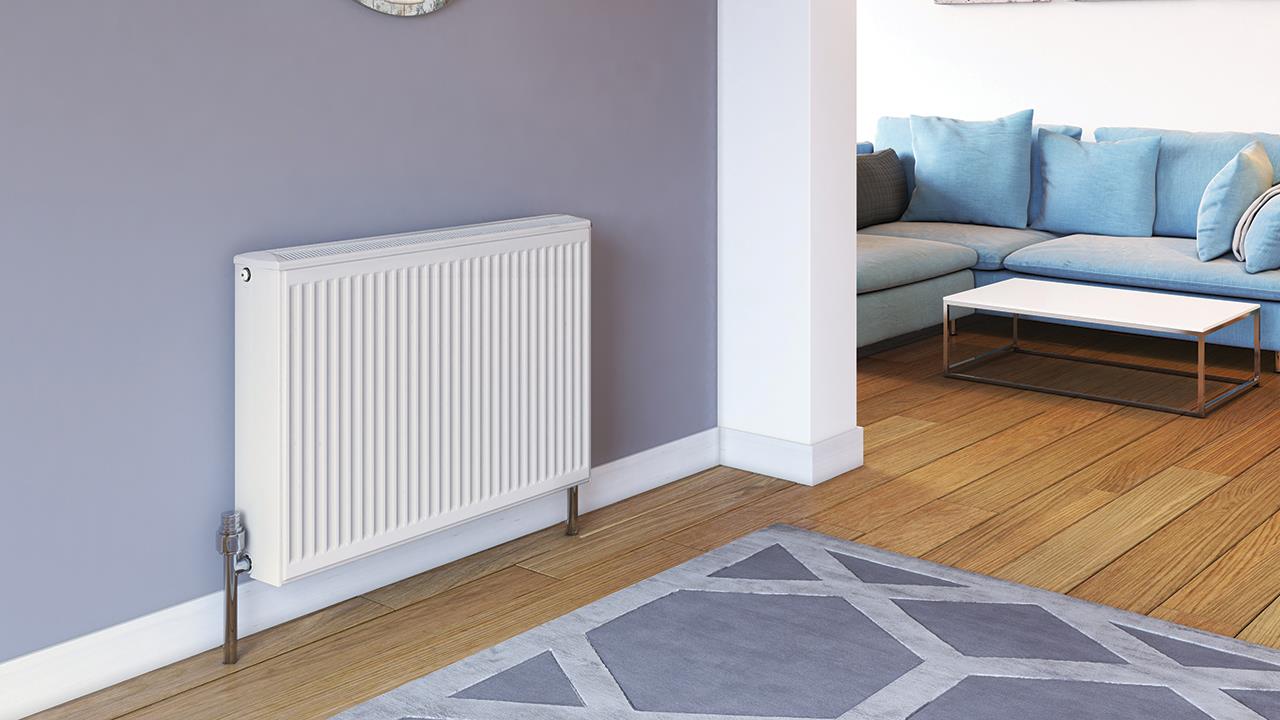

Many property owners are choosing to retrofit their homes with air source heat pumps. However, when retrofitting a heat pump to an existing property, installing underfloor heating can be complex, impractical, and costly. In this situation, choosing radiators offers a solution.
Key factors
Specifying radiators for use with heat pumps is largely the same as specifying them with gas boilers, however it is crucial that installers consider heat loss to avoid costly mistakes.
The first and most important thing to do is to inspect the pipework, because if the system includes microbore pipework drops, radiators will be a no-go.
When using radiators, consider the characteristics of each room to determine its thermal performance. Check the quality and type of windows – single glazing is the nemesis of heat pump systems, and sometimes the property might require upgrades to older double-glazing systems.
The size of the wall cavities and the amount of insulation within them should also be considered, alongside the loft insulation, which should be at least 200mm thick. The size, shape, and ambient temperature of the room should also be part of the calculations – a small bedroom will usually have a higher ambient temperature than a large living room.
Size matters
Once it has been discerned that the property is suitable for radiators, it may transpire that the existing ones need replacing with options that are more suited to the lower flow temperatures associated with heat pumps. In some cases, however, the property’s thermal performance may mean that the original radiators can be retained and, if so, a power flush system should be used to remove any debris that may interfere with airflow.
Radiators suitable for this type of heating system often need to be larger than conventional emitter systems, because of the lower flow temperatures associated with heat pumps. One of the reasons for the drive to swap boilers for heat pumps is that pumps are far more efficient. Boiler systems operate at approximately 70-80°C, whereas heat pumps have a flow of around 40-50°C.
It is important to apply the manufacturer’s Delta T correction. This is a simple equation that tells you which size the radiator needs to be.
For example, in the case of 75°C flow temperature, a typical 600mm (h) x 700mm (l) single panel, single convector radiator will have an output of approximately 0.656kW. If we put 45°C flow through the same radiator, a correction factor of 0.365 needs to be used.
Installers need to multiply 0.656 by 0.365, which gives them 0.251kW in output. To achieve the same output, the radiator would therefore need to be replaced with a bigger size. In the example above, a 600mm (h) x 1,100mm (l) double panel, double convector radiator would need to be installed, providing approximately 0.696kW.
Another option
Where the existing radiators aren’t suitable, the obvious choice is often to install fan-assisted radiators – but be aware that they require an electrical connection. Fan-assisted radiators are an easy way to blow warm air around the room and distribute heat more evenly while keeping energy consumption low.
If there is no power supply for the electrical connection, installers can use deeper, triple panel radiators. They have a high heat dispersion rate but take up less wall space.
And, of course, stylish vertical feature radiators can enable homeowners to balance aesthetics with system requirements.
Lastly, even with the government grants and loans available, heat pumps are still a big investment for a homeowner, and installers may find that they get some push back from the customer about additional spend on new radiators. If this happens, there is a third option: high temperature heat pumps. This technology can operate at temperatures up to 75°C, equivalent to gas boilers, making them more compatible with existing radiators.
Careful consideration
Whichever pump is installed, remember that the unit must be located as close to the building as possible, and with 1m clearance on all sides.
Also, make sure to remember not to mount the pump on a north-facing wall, which would will put more strain on the system and impact its efficiency.
There are further considerations that help with customer satisfaction without impacting performance. Firstly, do not install the pump close to bedroom windows. The unit does emit some noise, and this might disturb residents at night when ambient noise levels are low.
Secondly, a pump creates space requirements for additional equipment. When choosing a location, remember to account for a heat pump-ready cylinder, buffer tank of between 20-50l, a volumiser, and a control system.
If you'd like to keep up-to-date with the latest developments in the heating and plumbing industry, why not subscribe to our weekly newsletters? Just click the button below and you can ensure all the latest industry news and new product information lands in your inbox every week.